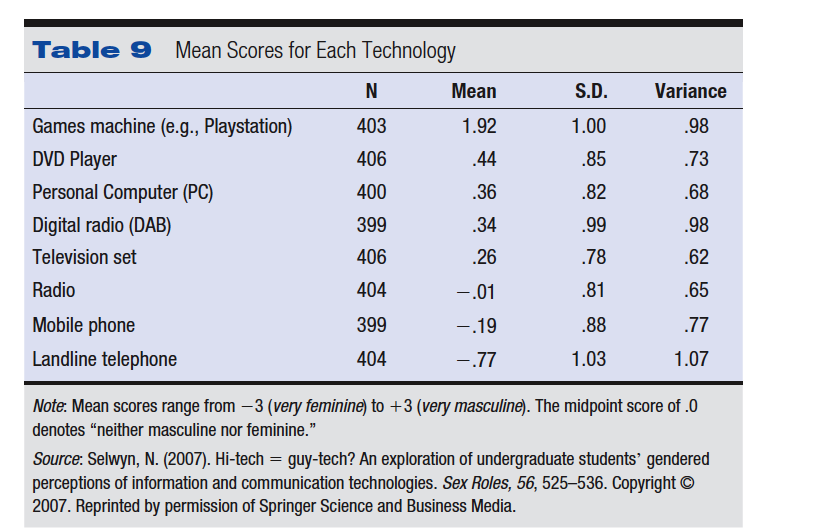Selwyn (2007) conducted a study of gender-related perceptions of information and communication technologies (such as video game systems, DVD players, and cell phones). The researcher asked 406 college students in Wales to rate 8 technologies in terms of their level of masculinity or femininity. The students rated each technology using a 7-point response scale, from –3 for very feminine to +3 for very masculine, with a midpoint of 0 for neither masculine or feminine. Table A (reproduced from Selwyn’s article) shows the mean, standard deviation, and variance of the students’ ratings of each technology (Adapted from: Aron, Arthur, Elaine Aron, and Elliot J. Coups. Statistics for Psychology. Upper Saddle River, N.J: Pearson Education, 2013).

Several mathematical characteristics can be used to evaluate data sets. The first is the N parameter, a baseline value that reflects the number of respondents surveyed. It was mentioned in the article that the total number of participants in the survey was 406, and the parameter N reflects how many of them took part in the measurement of each of the technologies. The second characteristic is the mean, which measures the average trend. Given the boundaries of the measurements (from -3 to +3), the mean value conventionally shows how feminine or masculine they are. We can see that the most masculine is gaming stations, and the most feminine technology is the landline phone. These technologies are sorted according to this characteristic in the list above, which means that the lower the technology in the list, the more feminine it is.
However, it is essential to know that the average is not a sufficiently representative characteristic because it does not account for the wide variation in the data. In order to study averages more reliably, standard deviations (SD) must be further explained. Roughly speaking, the lower the value of the standard deviation, the closer all the data are distributed around the mean, which means that the dispersion of the data is the smallest – a measure of outliers. The smallest SD was for radio (0.81), and personal computers (0.82), and the largest was for landlines (1.03) and game stations (1.00). In other words, one cannot judge with high confidence the reliability of the mean value for those technologies in which the SD value was large and more significant than the mean: too large deviations were observed in these cases. Perhaps these results may show that game stations are not genuinely masculine and landlines are not truly feminine because the values of their standard deviations are large. Finally, to simplify the understanding of the standard deviation, it is recommended that the variance be used to indicate the variability of the data. If the variance is zero, it means that all numbers in the set are identical, but in this case, there is no such variance. Consequently, respondents did give different estimates of gender by technology, with the maximum variability (range of values from each other and from the average) being characteristic of the landline phone (1.07) and the minimum characteristic of television. Based on all the data, it is appropriate to say that the game stations and landlines show the least reliability in terms of using the average, which means that it is not necessary to judge the gender affiliation of these technologies unequivocally. Otherwise, other technologies showed a slight bias toward masculinity but, in general, did not show a consistent tendency to take either side.